|
[Front Page] [Features] [Departments] [Society Home] [Subscribe]

The Australian Aquatic Garden
Nick Romanowski
Australian aquatic and wetland plants are much less familiar than most other Australian plants, partly because they aren't a single group but come from hundreds of genera and dozens of plant families, and partly because the classification of many of these groups is still being sorted out by botanists. However, many are already being grown in gardens, and the basic rules for keeping them are much the same as for waterplants from anywhere else in the world.
Ponds should include planting shelves (see diagram) at suitable depths for the species you plant to grow, whether you will grow these in a suitable soil spread on the shelves and pond bottom, or in pots for easier maintenance. In dams and wetlands, the shelves can be much wider. Soils don't need to be much deeper than 5 to 10 cm for most plants; any reasonable garden soil with up to 5% cow manure and a small amount of blood-and-bone is suitable.

Synthetic fertilizers are acceptable for some aquatics but not all and, as these aren't formulated for underwater use, they can cause unpredictable water-quality problems. A blanket of sand at least 4 cm deep over the soil will minimise leaching of nutrients into the water.
The main exception to these guidelines for aquatic plant feeding are the water lilies (Nymphaea) and sacred lotus (Nelumbo) which are so familiar that they are a natural starting point for this brief survey of Australian waterplants. Both groups are gross feeders; even 20% cow manure and 200 gm of blood-and-bone per wheel barrow of mix is not excessive for these plants.
Australian water lilies include at least 9 species, all of which are much more cold-sensitive than the exotic tropical hybrids available through general water garden nurseries. Many of these Australian species have been lumped together under N.gigantea. The true N.gigantea has round petals, and varies from blue to white to pink, fading with age. N.violacea is sharper-petalled, blue to mauve or sometimes white to pink. White species include N.elleniae, and N.pubescens which is usually tinged pink. N.immutabilis may be blue or white, always with a blue tinge.
The sacred lotus (Nelumbo nucifera) is one of our largest wildflowers. In southern Australia it must be grown in shallow water no more than 15 cm deep so that the soil will warm up quickly, but in the tropics it will grow much deeper. Most forms are pink to reddish-pink, but white is also sometimes seen. The most cold-tolerant form I have grown so far is from the southernmost population in Australian (now vanished) around Nangram Lagoon; this is white with pink-veining at the tips.
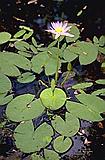 |
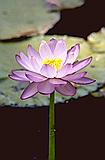 |
Nymphaea violacea (left) is found in northern Queensland, northern parts of the Northern Territory and the Kimberly region of Western Australia. The large flowers (right) are borne on long stalks up to 30 cm above the water surface and may be violet, blue or white in colour.
Select the thumbnail image or highlighted name for a higher resolution image (37k and 20k).
Photos: Keith Townsend
|
In southern Australia other plants can be used in place of water lilies, including the related watershield (Brasenia schreberi) with unusual elliptical leaves and purple flowers. Many marshworts (Nymphoides) species have very waterlily-like leaves, but the flowers are much smaller and often heavily fringed. N.indica is white-flowered with a yellow centre, and the leaves are huge. N.crenata has serrated leaf edges in most forms, but in the variation 'Purple Mosaic" these are smoother, and the leaf is richly marked with purple. Ottelia ovalifolia is also very decorative but not easy to maintain; even more difficult is the double-petalled form.
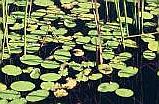 |
|
The floating leaves of Nymphoides crenata (top) make for a peaceful scene at Thirlemere Lakes south west of Sydney. The flowers of Nymphoides indica (bottom) have fringed petals.
Select the thumbnail image or highlighted name for a higher resolution image (61k and 22k).
Photos: Australian Plants Society (NSW) and Peter Sparshott
|
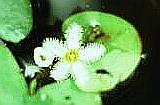 |
Floating plants will grow anywhere on the surface of the pond, but on larger waterbodies such as dams they are usually only seen near the fringes. Azolla ferns are often richly coloured in brick-red (A.pinnata) or coral pink (A.filiculoides).
Bladderworts (Urtricularia) aren't generally showy, but the massed yellow flowers of U.gibbba area an exception. Other species aren't as striking but are worth looking at more closely; for example the bright, fresh green of duckweeds, or the black-bearded liverwort Ricciocarpus natans.
Species more suited to somewhat shallower waters include the water milfoils (Myriophyllum), mostly with fine, lacy leaves underwater changing to a completely different shape as they rise into the air, M.papillosum is a larger species with tufts of pink flowers around the stems; the form 'Red Dragonfly" is my own selection with the upper leaf surface turning crimson in Spring, sometimes again in Autumn. My favourite form of the widespread M.simulans is 'Coral Pink' which can be very richly-coloured although less predictably so than 'Dragonfly Red'. M.verrucosum is usually red, but it is not ideal for dams as it can be very invasive; in ponds it is usually kept under control by tadpoles.
Other water milfoils remain mostly submerged at all times, including the deep-green M.salsugineum which only sends its colourful flowers on a short, leafy sprig above the surface.
Another form of the variable M.simulans from Kangaroo Island is a brilliant, fresh green, and only has tufts of growth above the water. Another colourful plant from this depth-range is Marsilea mutica, a fern with floating clover-like leaves marked with reds, tans and hints of other colours.
Shallow waters are home to many plants, including sprawling species which might be called ground covers- the term doesn't sound quite right here! Waterbuttons (Cotula coronipifolia) is one of the showiest with masses of yellow flowers, but Ludwigia peploides with buttercup-like flowers isn't far behind. True buttercups (Ranunculus) with yellow flowers include R.inundatus, although this is usually grown for its finely-divided, lacy-looking leaves. The small, round leaves of native bacopa (Bacopa monieri) may be partly hidden under lilac flowers in warm seasons, in contrast to the mats of common nardoo (Marsilea drummondii) which never flowers as it is a fern, but looks almost silver under a coat of fine hairs.
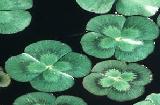 |
|
The clover-like leaves of nardoo, Marsilea mutica (top) feature attractive and colourful patterns. Myriophyllum species (bottom) are often found in shallow water and have a number of forms suited to cultivation.
Select the thumbnail image or highlighted name for a higher resolution image (27k and 41k).
Photos: Shortland Wetland Centre and Peter Sparshott
|
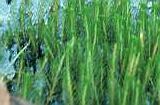 |
Other shallow water plants can be very eye-catching for their foliage alone, particularly water plaintain (Alisma plantago-aquatica) with rather heart-shaped leaves held high, although the shivering masses of tiny white flowers are also very decorative. Still others are quite inconspicuous, remaining hidden until they flower. Monkey flower (Mimulus gracilis) is an example, producing carpets of bluish, yellow-centred blossoms for months on end in a good season. Showy willowherb (Epilobium pallidiflorum) is almost impossible to see until it flowers, when its lilac flower columns can be seen even across a fair-sized dam.
Many wetland plants are usually found somewhere around the water's edge where they may dry out a bit at times, or be flooded at others. Swamp isotome (Isotoma fuviatilis) is a widely-grown example, usually a creeper covered in small, hand-like flowers from white to blue.
The knotweeds (Persicaria) have handsome foliage in many cases, in P.decipiens marked red or purple, and columns of small, pink flowers. Purple loosestrife (Lythrum salicaria) is a taller herb, and the flower-columns are so abundant that they are quite spectacular in any gardener's eyes.
Water's-edge plants often have yellow flowers, ranging from the rather frilly ones of Villarsia reniformis held well above the kidney-shaped leaves, to the spheres of drumsticks (Pycnosorus globosus) which can approach the size of a golf ball in some clones. The flowers of this plant dry and keep well, as do those of a true everlasting daisy, the yet-to-be-named swamp everlasting (Bracteantha sp.).
And finally, there is a group of plants which can't be said to be brilliant in colour, yet adds a rich texture without which no pond or dam will ever look natural. Grassy plants are well-appreciated overseas, yet in Australia they are barely known. In wetlands, the dominant family of grassy plants is the sedges, and these include some fine and distinctive species which also provide habitat for many wetland animals. Some make bold specimens in their own right; jointed twig rush (Baumea articulata) with tawny flower heads weeping from deep-green stems, or the great tussocks and pendulous spikes of tall sawsedge (Gahnia sieberiana). River club rush (Schoenoplectus validus) is a dust blue-green rush with chocolate flower heads.
Many small species are just as distinctive and decorative: the bright-green foxtail flowerhead soft tassell sedge (Carex fascicularis), leafy tussocks and palm-like flower heads of leaf rushes such as Cyperus excaltatus and C. vaginatus, and the wiry purplish foliage of echidna rush (Chorizandra enodis) with flower heads like little echidnas climbing the stems.
 |
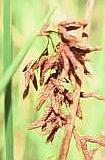 |
Grassy clumps of Carex sp. (top left) border a quiet backwater while flowering stems of Schoenoplectus validus (right) provide refuge and camouflage for an amphibious visitor. The leaves of water ribbons Triglochin sp (bottom left) add interest to a rocky pool.
Select the thumbnail image or plant names for higher resolution images (46k, 28k and 43k).
Photos: Kym and Peter Sparshott
|
 |
Other grass-like plants are also important in wetlands, from the fleshy, strap-like leaves of water ribbons (Triglochin procerum and its many allied species) to cumbungi (Typha domingensis and T.orientalis) with their upright, tan pokers. Among my personal favourites is tassel cord-rush (Restio tetraphyllus, especially when it is in flower), and the mace-shaped flower heads of Sparganium subglobosum. Even true grasses include the very decorate aquatic species, including wetland plants common reed (Phagmites australis) make one of the most handsome grassy specimen plants which can be imagined.
We live on a dry continent, with far fewer wetland areas than most other areas on earth. Yet Australian aquatic and wetland plants aren't restricted in variety- they are just poorly known. As our wetland plants become better known, they will open up whole new areas for gardeners; indeed, our dams, swamps and ponds could potentially be among the most diverse areas of Australian gardens.
This article is a reproduction of a paper presented at the ASGAP 18th Biennial Seminar which was held at Ballarat, Victoria, 1995.
Nick Romanowski is a zoologist with a sub-major in botany and a wetlands consultant whose studies have revolved around aspects of aquatic biology (native plants, native fishes and aquatic invertebrates). He is the owner and manager of Dragonfly Aquatics, specialising in Australian wetland plants and maintaining perhaps the largest range of these plants in cultivation.
Nick is the author of several books including Water and Wetland Plants for Southern Australia, Farming in Ponds and Dams, Aquatic and Wetland Plants, Planting Wetlands and Dams and Water Garden Plants and Animals.

[Front Page] [Features] [Departments] [Society Home] [Subscribe]
Australian Plants online - December 2000
Association of Societies for Growing Australian Plants
|